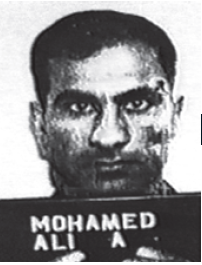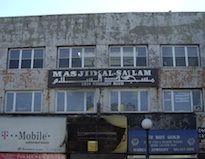Fort Hood Massacre & KSM What Do They Have in Common? Part One

Fort Hood & the KSM trial- Part I: What do these terrorism stories have in common?
By Peter Lance December 3rd, 2009
Al Qaeda’s Master Spy could be the key to them both
In its firestorm of coverage, the mainstream media has overlooked a potential link between the two biggest domestic terrorism stories of the day: the shootings at Ford Hood and the decision by the Justice Dept. to try accused 9/11 “mastermind” Khalid Shaikh Mohammed in New York City.
Five time Emmy-winning former ABC News correspondent and HarperCollins author Peter Lance shines a light on the man who may well be the greatest enigma in the “war on terror.”
 His name is Ali Abdel Saoud Mohamed, aka Ali Amirki or “Ali the American,” the ex-Egyptian Army officer who penetrated the CIA (briefly) in 1984, the John F. Kennedy Special Warfare Center at Fort Bragg from 1987 to 1989 and the FBI where he served as an informant from the early 1990’s, interacting with top federal prosecutors and Special Agents as he trained the cell responsible for the 1993 World Trade Center bombing and “Day of Terror” plots. Earlier he moved Osama bin Laden’s entourage from Afghanistan to Khartoum, set up the al Qaeda training camps in the Sudan, trained the Saudi billionaire’s own personal bodyguard and later served as the principal plotter in al Qaeda’s five year mission to blow up the U.S. Embassies in Kenya and Tanzania.
His name is Ali Abdel Saoud Mohamed, aka Ali Amirki or “Ali the American,” the ex-Egyptian Army officer who penetrated the CIA (briefly) in 1984, the John F. Kennedy Special Warfare Center at Fort Bragg from 1987 to 1989 and the FBI where he served as an informant from the early 1990’s, interacting with top federal prosecutors and Special Agents as he trained the cell responsible for the 1993 World Trade Center bombing and “Day of Terror” plots. Earlier he moved Osama bin Laden’s entourage from Afghanistan to Khartoum, set up the al Qaeda training camps in the Sudan, trained the Saudi billionaire’s own personal bodyguard and later served as the principal plotter in al Qaeda’s five year mission to blow up the U.S. Embassies in Kenya and Tanzania.
Ali Mohamed was the ticking time bomb at Fort Bragg who should have redefined the Army’s rules for uncovering traitorous Islamic radicals in the ranks 20 years before Maj. Nidal Malik Hassan went on his alleged rampage at Fort Hood.
But more importantly, for all the critics who think trying KSM in the Southern District of New York is a bad idea, Ali Mohamed could represent the Feds’ best witness at trial; insuring once and for all that Khalid Shaikh will finally be brought to justice.
The spy who hid in plain site
In the years leading up to the 9/11 attacks, no single agent of al Qaeda was more successful in compromising the U.S. intelligence community than Ali Mohamed. A member of the radical Egyptian Army unit that murdered President Anwar Sadat in 1981, Mohammed escaped prosecution, but he was later purged from the Egyptian military due to his radical Islamic views.
In 1983 he caught the attention of Dr. Ayman al-Zawahiri, five years before the doctor with the spectacles and go-tee joined bin Laden to form al Qaeda. Al Zawahiri saw Ali as the espionage agent he needed to penetrate the U.S.
 After the 1983 bombings of the U.S. embassy and the Marine barracks in Beirut, the CIA was hungry to recruit assets who understood the radical Islamic mindset. So with very little vetting, the Agency sent Ali to Hamburg where he went into a Hezbollah mosque only to blow his cover and get his name on a Watch List.
After the 1983 bombings of the U.S. embassy and the Marine barracks in Beirut, the CIA was hungry to recruit assets who understood the radical Islamic mindset. So with very little vetting, the Agency sent Ali to Hamburg where he went into a Hezbollah mosque only to blow his cover and get his name on a Watch List.
Undaunted, Mohamed got onto a TWA flight from Athens to JFK in 1985. On the brief trip across the Atlantic, he managed to seduce an older American woman named Linda Sanchez who was returning from vacation in Greece. They were married six weeks later at a drive-through wedding chapel in Reno. After that, Ali moved into Linda’s home in Santa Clara, California and set up an al Qaeda “switchboard” and sleeper cell with an ex-Egyptian medical student named Khalid Dahab.
In 1986 he drove to Oakland and enlisted in the U.S. Army, careful to stay under the radar and avoid the scrutiny of Officer Candidate School. Astonishingly, though still a resident alien, he was posted to Fort Bragg where he managed to work his way up to the rank of E5 (sergeant) and, without any security clearance, get posted to the highly secure JFK SWC where elite Green Beret and Delta Force officers train.
A chilling precursor
So far, in its official reaction to the Fort Hood massacre the U.S. Army has been taking a page from the Claude Raines school of crisis management; imitating the reaction of the duplicitous Capt. Renault in the film Casablanca who professed, “shock, shock” that there was gambling going on at Rick’s club only to be handed his winnings.
But two decades before Maj. Hasan allegedly dropped thirteen people in cold blood, key officials at Bragg were aware of Ali Mohamed’s openly jihadist views. They even used him in a training video, in which Ali declared (with chilling confidence) that it was the duty of all Muslims to change countries with secular governments into Islamic regimes.
“It’s an obligation,” said Ali on the training tape, “it’s not a choice.”
And how much was known at Bragg among the officer elite of Ali’s subversive agenda? Ask his own commanding officer, Col. Robert Anderson:
“I think you or I would have a better chance of winning the Powerball lottery, than an Egyptian major in the unit that assassinated Sadat would have getting a visa, getting to California, getting into the Army and getting assigned to a Special Forces unit. That just doesn’t happen.”
But it did and Ali was so audacious at Bragg that he announced to Anderson that he was going to use his leave to visit Afghanistan and hunt Soviets. It was an act that could have had global implications akin to the Soviet shoot down of Francis Gary Powers’ U-2 flight, if Mohamed had been captured or killed in the midst of the covert U.S. war to help the Mujahideen.
In an interview for my HarperCollins biography of Mohamed, Triple Cross, Anderson said that he tried to get Ali court martialed after he returned from Kabul and brazenly dropped two belts from Soviet Spetsnaz commandos on his desk. Bragging that he’d killed them, Ali wasn’t worried in the slightest that he’d be reprimanded and Anderson said he was told by a JAG officer that there was insufficient evidence “to convict anyone of anything.”
Does this resonate with the kind of audacious behavior Maj. Hasan exhibited at Walter Reed Army Hospital only to be given a pass? As the French say, “plus c’est change, plus c’est la meme chose.”
Al Qaeda’s secret spy in New York
But the Afghan theater of ops wasn’t where Ali Mohamed did his most damage. On weekends, in 1989 he began commuting up to New York from Fort Bragg where he trained Mahmoud Abouhalima, a six foot two-inch red headed Egyptian cab driver, Mohammed Salameh, a Palestinian illegal alien, and Nidal Ayad, a Kuwait émigré and Rutgers grad – all later convicted by Southern District prosecutors in the 1993 World Trade Center bombing.
 Working out of what the Feds called “the Jersey jihad office,” the Kennedy Boulevard based Al-Salaam mosque in Jersey City, Ali even played his Fort Bragg training video for the “brothers” as he schooled them in and weapons training and other covert operations.
Working out of what the Feds called “the Jersey jihad office,” the Kennedy Boulevard based Al-Salaam mosque in Jersey City, Ali even played his Fort Bragg training video for the “brothers” as he schooled them in and weapons training and other covert operations.
Should the Army have known about Ali’s clandestine trips back then? Maybe not initially, but the alarm bells should have gone off at the JFK SWC in November, 1990 when El Sayyid Nosair, another Ali trainee, gunned down Rabbi Meier Kahane, founder of The Jewish Defense League as he gave a speech at the Marriot Hotel on Lexington Avenue.
That night as multiple law enforcement units descended on Nosair’s house in New Jersey they found a treasure trove of intelligence suggesting that Ali Mohamed (who stayed with Nosair on his New York visits) had betrayed not only the U.S. Army, but his adopted country.
 They filled forty-seven boxes with evidence seized, including Green Beret manuals marked “Top Secret for Training” and communiqués classified as Secret from the Joint Chiefs of Staff.
They filled forty-seven boxes with evidence seized, including Green Beret manuals marked “Top Secret for Training” and communiqués classified as Secret from the Joint Chiefs of Staff.
Another memo, entitled “Location of Selected Units on 05 December 1988,” listed the precise positions of Special Operations Forces (SOF) worldwide—including the army’s Green Berets and Navy SEAL teams—along with details of their missions. That single communiqué could have easily gotten Mohamed indicted on charges of espionage and treason, defying the legal judgment of the JAG officer at Bragg who had spurned Lt. Col. Anderson’s request for a court martial.
A warning of the 1993 World Trade Center bombing
The cache also contained hints of al Qaeda’s most famous New York target: the World Trade Center. One passage inside Nosair’s notebook called for the “destruction of the enemies of Allah…by… exploding…their civilized pillars…and high world buildings.”
Considering the “stove piping” that existed back then, you might ask how would the FBI have known about Ali’s presence at Fort Bragg or his links to El Sayyid Nosair?
Fair question, until you realize that 16 months before the Kahane assassination, the FBI Special Operations Group followed Nosair and a group of other “ME’s” (middle eastern men) from a Brooklyn mosque to the Calverton shooting range on Long Island.
Over four weekends in July, the Bureau agents took dozens of surveillance photos of Nosair, Abouhalima, Salameh, Nosair and Ayad (all trained by Ali Mohamed) firing handguns, AK-47’s and other semi-automatic weapons. They even had shots of the chrome-plated .357 Magnum, Nosair would use to rub out the rabbi.
The “lone gunman”
Even more shocking, when you ponder why the dots weren’t connected, was the presence of Abouhalima and Salameh, Nosair’s intended getaway driver’s, at his New Jersey home the night of the assassination.
They were taken into custody; only to be released by the NYPD the next day. Later, despite the involvement of three co-conspirators, Chief of Detectives Joe Borelli labeled the assassination a “lone gunman shooting.”
Nosair, a Prozac popping janitor who worked in the basement of Manhattan’s civil court was tried locally by the Manhattan D.A. and to the surprise of Bill Greenbaum, the ADA who prosecuted the case, the Army kept their distance.
“We had people from Fort Bragg who came up,” he told me. “But then they went home and we never heard a word.”
Nosair lawyered up with William Kuntsler who succeeded in getting him convicted on mere weapons charges vs. the actual Kahane murder. Years after the 9/11 attacks Eleanor Hill, chief investigator for the House-Senate Joint Inquiry, revealed that Osama bin Laden himself helped pay for Nosair’s defense.
The first U.S. blood spilled by al Qaeda
The legal fee from the Saudi billionaire suggested that the rabbi’s death at the hands of an Ali Mohamed-trainee was the first in a series of al Qaeda missions directed against U.S. citizens; the next being the murder of six people in the 1993 World Trade Center bombing, the 1998 Embassy bombings, the loss of 17 sailors in the bombing of the U.S. Cole in 2000 and the mass murder of 2,976 on 9/11.
Ali Mohamed was personally connected to three of those five acts of terror. In the Embassy plot, he actually took the surveillance pictures that bin Laden used to pinpoint the location of the suicide truck bombs.
And what about the culpability of the two “Bin Laden offices of origin;” The FBI’s New York Office (NYO) and the Office of the U.S. Attorney for the Southern District of New York (SDNY) in failing to sniff out Mohamed as an al Qaeda spy?
In retrospect their record is shameless. But the seeming inability of the Southern District Feds to connect the dots continued up through the mid 1990’s.
In prepping for the 1995 “Day of Terror” plot, an al Qaeda scheme to blow up the bridges and tunnels into Manhattan, assistant U.S. attorneys Patrick Fitzgerald and Andrew C. McCarthy put together a list of 172 un-indicted co-conspirators.
Ali Mohamed was on the list along with Osama bin Laden and a little known individual named Waleed al Noor – co-owner with Egyptian Mohammed El-Attris of a small check cashing and mailbox story in Jersey City called Sphinx Trading.
If the Feds had any doubts about how “mobbed up” with al Qaeda Sphinx was, all they had to do was visit the building that housed the “Jersey Jihad” office and the al Salaam mosque where blind Sheikh Omar Abdel Rahman, al Qaeda’s spiritual leader, held court. Sphinx Trading was on the ground floor.
The 9/11 dots that never got connected
One of the most shocking discoveries I made in researching Triple Cross was that, six and a half years after McCarthy and Fitzgerald put Waleed al-Noor on that list with bin Laden and Ali Mohamed, Khalid al-Midhar and Salim al-Hazmi, two of the muscle hijackers who flew AA Flight #77 into the Pentagon on 9/11, got their fake ID’s at Sphinx from Mohammed El-Attriss, al-Noor’s partner.
Meeting Mohamed face to face
In 1996, Assistant U.S. Attorney Patrick Fitzgerald (now the top Federal prosecutor in Chicago) was charged by DOJ brass with getting an indictment of bin Laden. He turned to Squad I-49 in the FBI’s NYO where he began working with Special Agents Jack Cloonan and Dan Coleman.
By the summer of 1997, suspecting that something very bad was developing in Africa, Fitzgerald sent Coleman to Nairobi where he searched the home of Wadih El Hage, a bin Laden confident who was one of the principal bombing plotters.
Coleman was shocked to discover links between El Hage and Ali Mohamed, who had been cooperating with the Feds since 1992. That prompted Fitzgerald himself to fly across country to Sacramento where Ali was then living. In a face to face meeting, the federal prosecutor naively hoped he could turn Mohamed.
But Ali was not about to betray his “sheikh,” Osama. He actually admitted to Fitzgerald that he “loved” bin Laden and “believe[d] in him.” Then, he uttered words that amounted to treason; boasting that he didn’t need a fatwa to make war on the U.S., since America was “the enemy.” There was no way he was going to betray the jihad to these hapless Feds. Finally, he got up and left.
Moments later, Fitzgerald turned to Cloonan and said, “That is the most dangerous man I have ever met. We cannot let this man out on the street.” But that’s just what he did; allowing Ali to remain free for another 10 months; waiting to arrest him until a month after the bombs went off in Africa killing 224 and injuring thousands. It was a plot that Ali had been perfecting since 1993.
Cutting a deal with the devil’s “aide”
Back at Fort Bragg, Col. Anderson, Ali’s C.O. had described him to me as a “fanatic.” He wasn’t the devil, the Colonel said, “ he was more like the aide to the devil. He had an air about him; a stare, a very coldness that was pathological.”
Does that not echo the growing testimony we’ve heard from Army colleagues who interacted for years with Maj. Nidal Malik Hasan?
It took Fitzgerald more than a year to get any real cooperation out of Mohamed. It wasn’t until the year 2000 that Ali finally pled guilty to the Embassy bombings in return for being spared the death penalty.
The problem was, as the months counted down to the 9/11 attacks, why didn’t he give up the “planes as missiles plot?” From what Cloonan told me, Mohamed knew every detail. How could a top Fed like Pat Fitzgerald cut a deal with al Qaeda’s chief spy and not squeeze the truth out of him about bin Laden’s ultimate goal?
In PART TWO we’ll look at how much Ali may have known about the 9/11 plot and why, if the Feds were smart, he could become the secret weapon against KSM.




Recent Comments